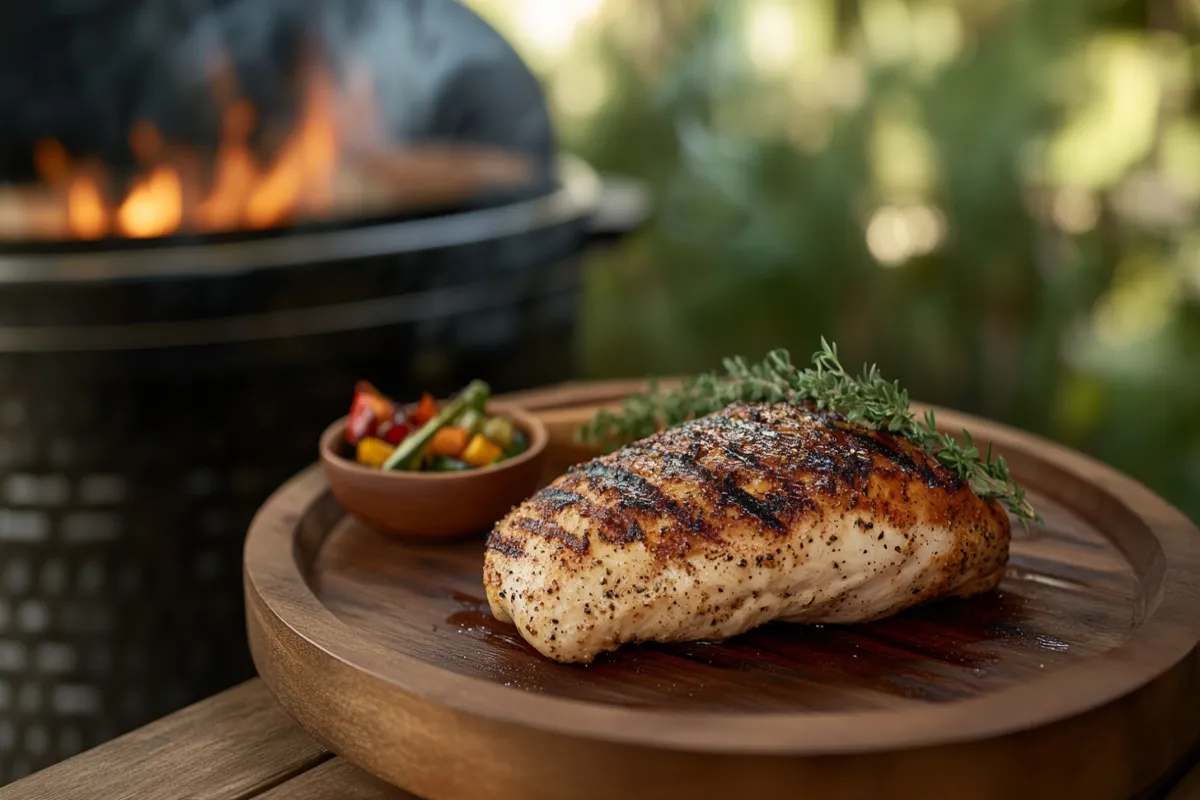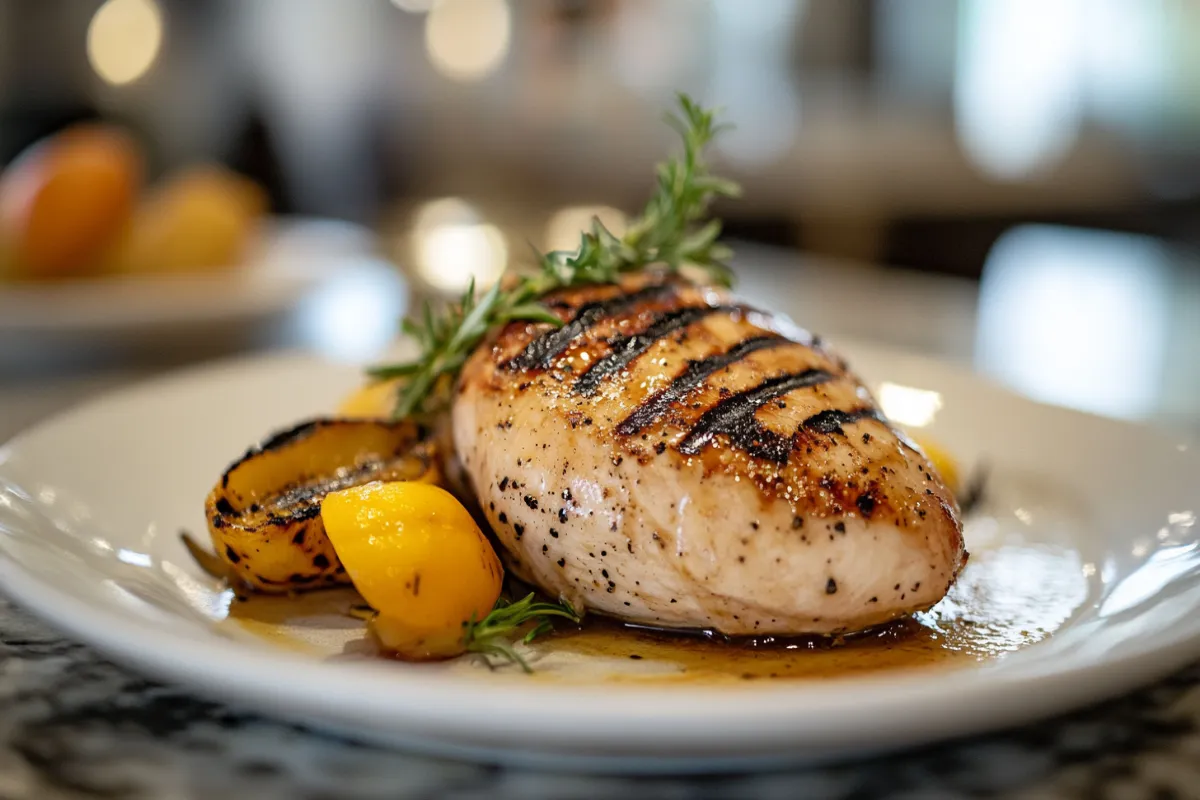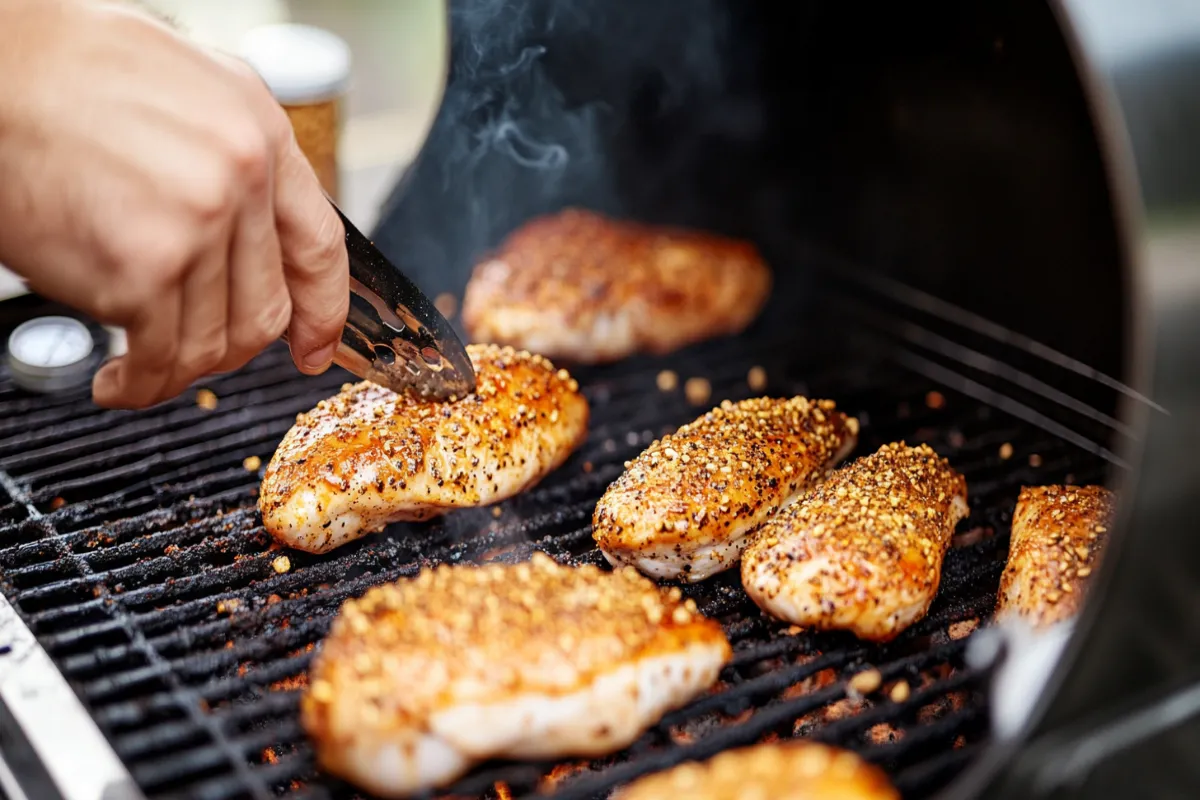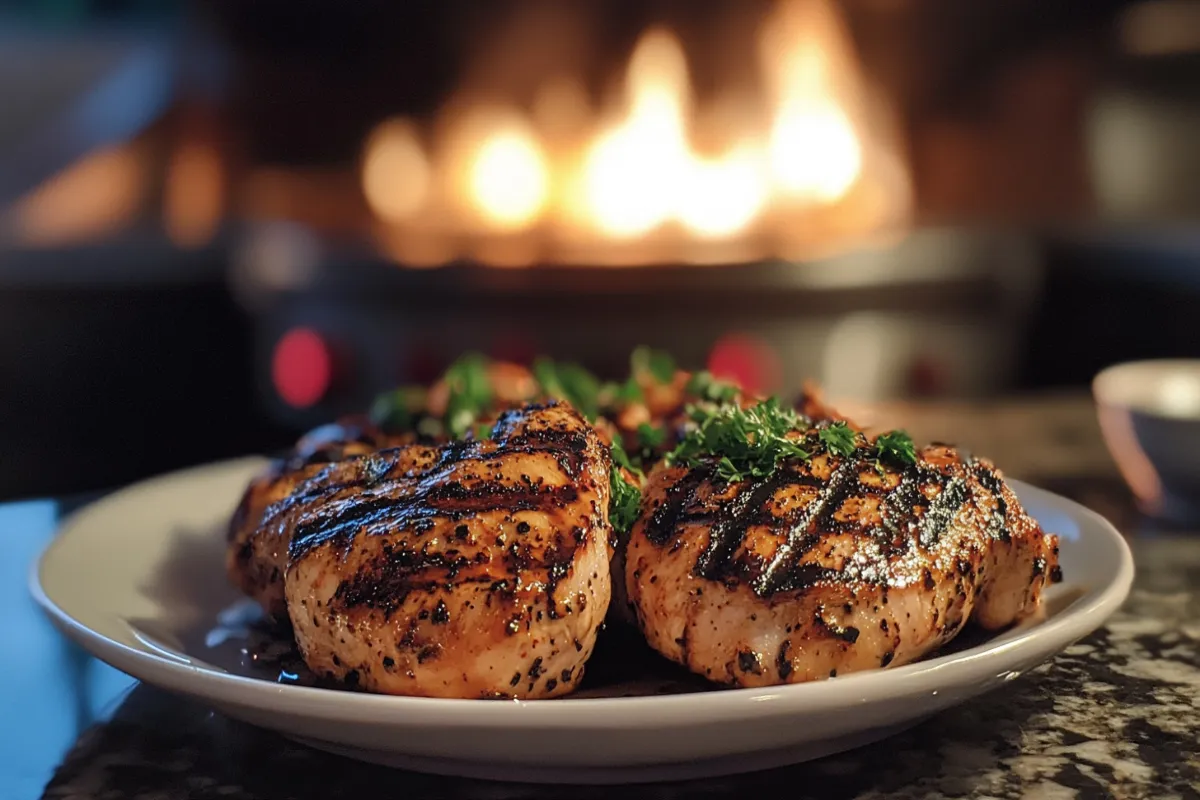Outline:
- Introduction
- The History and Popularity of Pellet Grills
- Health Benefits of Grilling Chicken Breast
- Choosing the Right Wood Pellets for Chicken Breast
- Essential Tools for Pellet Grilling Chicken Breast
- Ingredients for Pellet-Grilled Chicken Breast
- Step-by-Step Guide to Cooking Chicken Breast on a Pellet Grill
- 7.1 Prepping the Chicken Breast
- 7.2 Setting up the Pellet Grill
- 7.3 Grilling Techniques and Tips
- Common Mistakes to Avoid When Grilling Chicken Breast
- Variations and Customizations
- Best Pairings for Pellet-Grilled Chicken Breast
- Frequently Asked Questions (FAQs)
- Conclusion
Introduction
Cooking chicken breast on a pellet grill is one of the best ways to achieve a smoky, flavorful, and tender meal. If you’ve ever struggled with overcooked or dry chicken breast, the pellet grill offers a perfect solution. By utilizing wood pellets, this type of grill combines the convenience of modern grilling technology with the rich, mouth-watering flavors of traditional barbecue. In this comprehensive guide, you’ll learn how to grill chicken breast on a pellet grill with the best techniques, tools, and tips to ensure your chicken turns out juicy and delicious every time.
Pellet grills, often referred to as the “set it and forget it” option in grilling, allow you to maintain precise temperatures, making it easier than ever to grill chicken to perfection. The key to success lies in combining low-and-slow smoking techniques with quick, high-heat grilling to lock in moisture and achieve that beautiful seared crust.
Whether you’re a beginner griller or a seasoned pitmaster, mastering pellet-grilled chicken breast will add a valuable skill to your cooking repertoire. This guide will take you through the step-by-step process, from choosing the best wood pellets to selecting the ideal cooking method, so you can consistently enjoy succulent, flavorful chicken breast.
The History and Popularity of Pellet Grills
The rise of the pellet grill can be traced back to the late 20th century. These grills were invented in the 1980s by Joe Traeger, who developed the first wood pellet grill that automated the process of maintaining a consistent temperature. Pellet grills have since gained massive popularity for their ease of use and ability to infuse food with the rich flavor of wood smoke.
Unlike traditional grills, pellet grills use compressed wood pellets as fuel, which are fed into a firepot by an auger. This controlled feeding system allows for consistent heat and smoke output, which is crucial when slow-cooking or smoking delicate meats like chicken breast. Many pellet grills also come equipped with smart technology that allows users to monitor and control temperatures remotely through apps.
In recent years, pellet grills have become a favorite among both home cooks and professional BBQ enthusiasts for their versatility. You can smoke, roast, grill, and even bake on a pellet grill, making it a true all-in-one cooking machine. The ability to cook meat low and slow while imparting that sought-after smoky flavor is a game-changer, especially when grilling lean meats like chicken breast, which can dry out easily.

Health Benefits of Grilling Chicken Breast
Chicken breast is a lean and nutritious protein source, making it an excellent choice for anyone looking to eat healthily. When cooked properly, it offers a low-fat, high-protein meal that is also rich in essential vitamins and minerals. Let’s look at some of the top health benefits:
- Low in Fat: Boneless, skinless chicken breast contains very little fat, especially when compared to other cuts of meat. This makes it a great option for people looking to reduce their fat intake.
- High in Protein: Chicken breast is packed with protein, which is essential for muscle growth and repair. A single 3-ounce serving of grilled chicken breast contains around 25 grams of protein.
- Rich in Nutrients: Chicken breast provides important nutrients like vitamin B6, niacin, phosphorus, and selenium. These nutrients are crucial for maintaining a healthy metabolism, supporting immune function, and promoting bone health.
- Lean and Satisfying: Because chicken breast is lean and packed with protein, it can help you feel full and satisfied for longer periods. This makes it an ideal food for weight management.
- Less Oil Required: Grilling chicken breast on a pellet grill means you don’t need to rely on heavy oils or fats for cooking. The heat and smoke from the grill naturally enhance the flavor of the meat, making it unnecessary to add excessive amounts of butter or oil.
By using a pellet grill, you can enhance the natural flavors of the chicken without adding extra fats or unhealthy ingredients. Plus, grilling allows fat to drain away from the meat, reducing the overall fat content of the meal.
Choosing the Right Wood Pellets for Chicken Breast
One of the best features of a pellet grill is its ability to impart different flavors based on the type of wood pellets you use. When cooking chicken breast, choosing the right wood can make all the difference. Here are some of the best wood pellet options for grilling chicken breast:
- Applewood: Applewood pellets give a mild, slightly sweet flavor that complements chicken breast beautifully. They’re perfect if you’re looking for a subtle smoky taste without overpowering the natural flavor of the chicken.
- Cherry: Cherry pellets also offer a mild and sweet smoke, adding a rosy color to the chicken. The fruity flavor pairs exceptionally well with poultry.
- Hickory: Hickory provides a stronger, more robust smoky flavor that is popular in BBQ. While bold, it can still work well with chicken breast if you enjoy a more intense smoke profile.
- Pecan: Pecan wood offers a slightly nutty and rich flavor, adding depth to chicken without being too overpowering. It’s a great option if you want a bit more complexity in the smoke.
- Mesquite: Mesquite pellets produce a strong and earthy smoke, which is more commonly used for beef. However, if you enjoy a stronger, bolder flavor, you can experiment with mesquite on chicken.
Tips for Choosing Wood Pellets
- Go for Quality: Always choose high-quality wood pellets that are free from fillers, binders, or artificial additives. 100% hardwood pellets are ideal.
- Blend Options: Some pellet brands offer blends of different woods, providing a balance of flavors. Blends like hickory and applewood can offer a nuanced flavor profile.
- Avoid Overpowering Smoke: Chicken breast is delicate, so avoid using overly strong woods like mesquite or oak unless you’re pairing them with a robust seasoning or marinade.
Essential Tools for Pellet Grilling Chicken Breast
While pellet grills simplify the cooking process, having the right tools can further elevate your grilling game. Here are some must-have items:
- Meat Thermometer: One of the biggest challenges when cooking chicken breast is ensuring it’s cooked through without becoming dry. A reliable digital meat thermometer will help you monitor the internal temperature, ensuring it reaches 165°F without overcooking.
- Grill Tongs: Long-handled grill tongs are essential for flipping the chicken without puncturing it, which helps retain the juices.
- Basting Brush: A silicone basting brush is useful if you plan to apply marinades, sauces, or glazes during grilling. This will help distribute flavors evenly without damaging the meat.
- Grill Cover or Lid: Keeping the grill closed during cooking helps maintain a consistent temperature and enhances the smoky flavor by trapping the smoke inside.
- Wood Pellet Storage: Properly storing your wood pellets is crucial to maintain their quality. Keep them in a dry, airtight container to prevent them from absorbing moisture.

Ingredients for Pellet-Grilled Chicken Breast
To make perfect grilled chicken breast, you’ll need simple, high-quality ingredients that let the natural flavors of the chicken and smoke shine through.
- 4 boneless, skinless chicken breasts (about 6 ounces each)
- 2 tablespoons olive oil (or any other halal cooking oil)
- 1 teaspoon garlic powder
- 1 teaspoon onion powder
- 1 teaspoon smoked paprika
- 1 teaspoon black pepper
- 1 teaspoon salt (optional, adjust to taste)
- Your choice of wood pellets (applewood, cherry, or hickory recommended)
Optional ingredients:
- Marinade of choice (such as lemon-garlic, herb, or soy-based)
- BBQ sauce for basting
- Fresh herbs for garnish (like parsley or cilantro)
Step-by-Step Guide to Cooking Chicken Breast on a Pellet Grill
1 Prepping the Chicken Breast
- Trim and Clean: Start by trimming any excess fat from the chicken breasts. Rinse them under cold water, and then pat dry with paper towels.
- Seasoning: Rub each chicken breast with olive oil. This helps the seasoning adhere to the meat and also prevents the chicken from sticking to the grill. Mix together garlic powder, onion powder, smoked paprika, pepper, and salt, then evenly coat both sides of the chicken breasts with this seasoning mixture.
- Marinate (Optional): If you have time, marinating the chicken for 1-2 hours can infuse more flavor. A simple marinade of lemon juice, olive oil, minced garlic, and herbs works well. Alternatively, you can brine the chicken for 4-6 hours in a saltwater solution for extra juiciness.
2 Setting up the Pellet Grill
- Preheat the Grill: Turn your pellet grill on and set it to 225°F. Allow it to preheat for about 10-15 minutes. This ensures the grill reaches the desired temperature and starts generating smoke.
- Load the Hopper with Wood Pellets: Choose your wood pellets based on the flavor profile you want to achieve. For chicken, applewood or cherry wood pellets work great for a light, fruity smoke, while hickory adds a bolder taste.
- Indirect Heat Setup: Pellet grills allow for indirect cooking, which is key when cooking chicken breast low and slow. Make sure your grill’s heat is set for indirect grilling to avoid burning the exterior before the chicken is fully cooked inside.
3 Grilling Techniques and Tips
- Low and Slow Cooking: Place the seasoned chicken breasts on the grill grates, ensuring they are spaced evenly apart. Close the grill lid and smoke the chicken at 225°F for about 60 minutes. This slow cooking method allows the chicken to absorb the smoky flavor.
- Increase the Heat: After an hour of low-and-slow smoking, increase the grill temperature to 350°F to finish cooking. This step will help crisp up the outside while locking in the juices.
- Monitor the Temperature: Use a meat thermometer to check the internal temperature of the chicken breasts. The chicken is done when it reaches 165°F at the thickest part of the meat. Be careful not to overcook, as this will result in dry, tough chicken.
- Rest the Chicken: Remove the chicken from the grill and let it rest for 5-10 minutes before slicing. This resting period allows the juices to redistribute throughout the meat, ensuring maximum juiciness.

Common Mistakes to Avoid When Grilling Chicken Breast
- Not Preheating the Grill: Always make sure your grill is fully preheated before placing the chicken on it. This ensures even cooking and better searing.
- Cooking at Too High a Temperature: Grilling chicken breast at high heat can cause it to dry out quickly. Always start with a lower temperature (around 225°F) and only increase the heat toward the end to sear the chicken.
- Not Using a Meat Thermometer: Guessing when the chicken is done can lead to either undercooked or overcooked chicken. A meat thermometer takes the guesswork out, ensuring perfectly cooked chicken every time.
- Skipping the Rest Period: Resting the chicken after grilling is essential for keeping it juicy. Cutting into the chicken immediately after removing it from the grill can cause the juices to run out, leaving the meat dry.
Variations and Customizations
The basic pellet-grilled chicken breast recipe is incredibly versatile, allowing for a range of flavor enhancements. Here are some variations you can try:
- Cajun-Spiced Chicken: Add a bold, zesty flavor to your chicken by rubbing it with a mix of Cajun spices, including cayenne pepper, paprika, garlic powder, and thyme.
- Herb-Marinated Chicken: For a fresh and aromatic twist, marinate the chicken in olive oil, lemon juice, garlic, and a combination of fresh herbs like rosemary, thyme, and parsley.
- Honey Mustard Glazed Chicken: In the last 10 minutes of grilling, brush the chicken with a mixture of honey, mustard, and a dash of garlic powder to create a sweet and tangy glaze.
- Lemon Pepper Chicken: For a light and zesty option, season the chicken with lemon zest, freshly ground black pepper, and a drizzle of olive oil before grilling.
- BBQ Chicken: Baste the chicken with your favorite halal BBQ sauce in the final 15 minutes of grilling to create a smoky, caramelized crust.
Best Pairings for Pellet-Grilled Chicken Breast
Pellet-grilled chicken breast is a versatile dish that pairs well with a variety of sides. Here are some delicious pairing options to elevate your meal:
- Grilled Vegetables: Serve your chicken with a medley of grilled vegetables like zucchini, bell peppers, asparagus, and red onions. The smoky flavor from the pellet grill complements the sweetness of the veggies.
- Fresh Salads: A light and refreshing salad, such as a cucumber and tomato salad with olive oil and lemon dressing, pairs perfectly with the rich, smoky chicken.
- Rice or Quinoa: A side of fluffy rice or quinoa is a healthy and filling accompaniment that can soak up the flavorful juices from the chicken.
- Grilled Potatoes: Toss baby potatoes in olive oil, salt, and pepper, then grill them until crispy. The potatoes provide a satisfying, hearty contrast to the tender chicken.
- Pasta Salad: A cold pasta salad with a vinaigrette dressing, fresh vegetables, and herbs offers a delightful contrast to the smoky warmth of the grilled chicken.
Frequently Asked Questions (FAQs)
1. How long does it take to cook chicken breast on a pellet grill?
Cooking chicken breast on a pellet grill typically takes 1-1.5 hours. Start by smoking the chicken at 225°F for about 60 minutes, then increase the temperature to 350°F to finish cooking.
2. What wood pellets work best with chicken?
Fruity wood pellets like apple or cherry are ideal for chicken, offering a mild, sweet flavor. For a bolder taste, you can use hickory or pecan pellets.
3. Should I brine the chicken breast before grilling?
Brining chicken breast is optional but highly recommended for added moisture and tenderness. A basic brine made from water, salt, and sugar will ensure your chicken stays juicy during grilling.
4. How do I keep chicken breast from drying out on the grill?
To avoid drying out the chicken breast, grill it at a lower temperature (225°F) for the majority of the time, then raise the heat at the end to sear the outside. Also, use a meat thermometer to avoid overcooking.
5. Can I cook frozen chicken breast on a pellet grill?
It’s best to thaw chicken breasts before grilling to ensure even cooking. Cooking frozen chicken can result in uneven cooking and may take significantly longer to reach the proper internal temperature.
Conclusion
Cooking chicken breast on a pellet grill is an excellent way to enjoy a flavorful and healthy meal with minimal effort. By mastering the low-and-slow cooking method and choosing the right wood pellets, you can ensure your chicken is tender, juicy, and packed with smoky flavor. Whether you’re grilling for family dinners or weekend BBQs, this method is sure to impress.
The beauty of cooking with a pellet grill is that you have the ability to control every aspect of the grilling process, from the temperature to the type of wood used for smoking. By following the tips and techniques in this guide, you can easily perfect your grilling skills and create delicious, perfectly cooked chicken breast every time.

